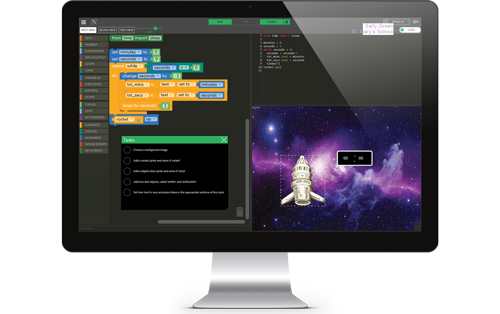Python Programming for Key Stage 3
Aug. 19, 2025
Teaching Python to Key Stage 3 students (ages 11–14) is both exciting and challenging. At this stage, learners are ready to move on from visual, block-based programming to text-based coding. With the right support, they can develop skills that will set them up for success throughout their computing education.
This guide shares practical strategies, project ideas, and resources to help you deliver Python lessons that engage every KS3 learner.
Understanding Your Learners
Students arrive in KS3 with very different experiences. Some may have used 2Code in Purple Mash or other block-based tools, while others may be completely new to programming. This diversity means you’ll need to differentiate your teaching to meet learners where they are.
At this age, students are developing abstract thinking skills, making it the perfect time to introduce text-based code. The key is balance: activities must be challenging enough to stretch learners, but achievable so they feel successful quickly.
Essential Python Concepts for KS3
Variables and Data Types
Start with the basics: variables and data types. Use simple, relatable examples – storing names, ages, favourite colours, or sports scores. Show how Python handles data types like strings, integers, and floats, using plenty of interactive exercises to reinforce understanding.
Input and Output
Programs that take input and give output are instantly engaging. Begin with small, purposeful projects like calculators or questionnaires. Linking code to students’ real lives makes Python feel relevant.
Conditional Logic
KS3 students understand decision-making well. Use real-life examples, like choosing activities based on weather or calculating grades. Flowcharts and pseudocode help students plan before coding, reducing cognitive load.
Loops and Repetition
Introduce loops through patterns, countdowns, and animations. Link to maths sequences for cross-curricular impact. This makes loops both practical and easy to visualise.
Project Ideas for KS3 Python Lessons
Personal Interest Apps
Let students create projects around their own interests: music playlists, sports trackers, or mini social media profiles. Personalisation builds ownership and motivation.
Game Development
Games are a perfect entry point. Number guessing games, word puzzles, and text-based adventures teach logic while keeping lessons fun. Start simple, then introduce graphics libraries as confidence grows.
Data Analysis
Students enjoy analysing data they care about. Sports stats, surveys, or weather data can all be used to teach lists, dictionaries, and plotting graphs. This builds digital literacy alongside coding skills.
Creative Computing
Coding doesn’t just have to be technical. Projects that generate patterns, animations, or interactive stories appeal to creative students, showing that Python can be used for self-expression.

Differentiation Strategies
Supporting Less Confident Learners
Provide scaffolding with template code, step-by-step guides, and lots of encouragement. Pair programming works well, allowing students to support each other.
Extending Advanced Learners
Offer stretch challenges, open-ended projects, or independent tasks. More experienced students can also act as peer tutors, reinforcing their own knowledge while helping others.
Addressing Different Learning Styles
Use a mix of approaches: demonstrations, hands-on coding, collaborative work, and problem-solving challenges. A varied toolkit ensures all students can access key concepts.
Using the Right Tools
Choose software that supports learners at different levels. Platforms like Python in Pieces with block-to-text transitions help beginners bridge the gap, while self-assessment features encourage reflection and independence.
Assessment in Python Lessons
Formative Assessment
Use quick coding challenges, debugging tasks, and peer reviews to monitor understanding without adding pressure.
Project-Based Assessment
Let students demonstrate learning through projects and portfolios rather than written tests. Giving them choice in project topics boosts motivation while still covering essential concepts.
Peer Assessment
Structured peer feedback helps learners evaluate code quality, efficiency, and creativity. It also develops teamwork and communication skills that are valuable beyond computing.
Overcoming Common Challenges
Syntax Struggles
Moving from blocks to text can feel daunting at first. Help students see error messages as part of the learning process rather than failures. Tools like Python in Pieces make the transition smoother by showing block and text code side by side, letting students debug in a familiar environment while gradually building independence with Python.
Maintaining Engagement
Keep lessons varied and connected to student interests. Use feedback to adapt your teaching and keep momentum going.

Balancing Independent and Group Work
Mix individual practice with collaborative projects. Make expectations for teamwork clear so everyone contributes fairly. Getting involved in initiatives like the Hour of Code is a simple way to spark motivation.
Aligning with the National Curriculum
Programme of Study Links
Python lessons should help students understand algorithms, develop programming skills, and build computational thinking – all key KS3 requirements.
Cross-Curricular Links
Python projects can connect with maths, science, geography, and history. Analysing scientific data or mapping geographical information demonstrates coding’s relevance beyond computing.
Resources and Tools
Choosing the Right Environment
Select environments that are simple, supportive, and accessible across devices. Cloud-based platforms are often best for consistency and avoiding installation issues.
Building a Resource Bank
Curate tutorials, templates and extension activities. Check quality before sharing resources with students.
Professional Development for Teachers
Keeping Skills Fresh
Python education evolves quickly. Join professional communities, try new projects, and stay engaged with emerging tools and techniques. Your enthusiasm directly influences student outcomes.
Building Department Capacity
Share best practices with colleagues, mentor those new to Python, and develop consistent approaches across year groups. Collaboration strengthens provision school-wide.
Preparing Students for the Future
KS3 lays the foundation for GCSE Computer Science and beyond. More than just covering curriculum content, your role is to build problem-solving skills, systematic thinking, and confidence.
Show students that coding is accessible to everyone. With the right support, every learner can succeed in Python and develop skills that will serve them far beyond school.
Final Thoughts
Teaching Python in KS3 is about more than syntax and code structures. It’s about giving students the confidence to problem-solve, create, and explore. By combining structured learning with opportunities for creativity and personalisation, you’ll help students see coding as both a valuable skill and a form of expression.
The foundations you build in KS3 can inspire a lifelong journey in computing – whether that leads to future study, a career in tech, or simply the confidence to thrive in an increasingly digital world.